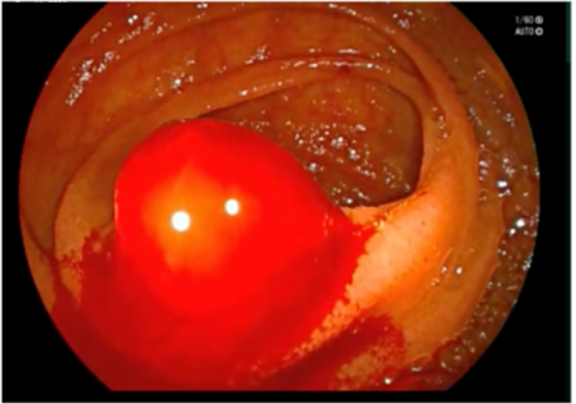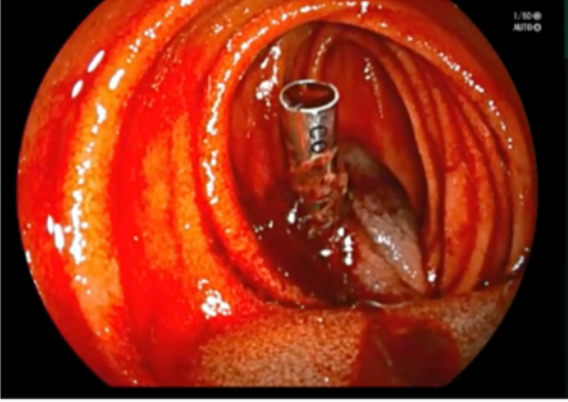Sunday Poster Session
Category: GI Bleeding
P0981 - Blue Rubber Bleb Nevus Syndrome: A Case Report and Review
Sunday, October 26, 2025
3:30 PM - 7:00 PM PDT
Location: Exhibit Hall

Durga Kumar, DO
HCA Florida Largo Hospital
Largo, FL
Presenting Author(s)
Durga Kumar, DO, Nayeem Chowdhury, DO, Sepideh Farzin, MD, FACG, Meir Mizrahi, MD
HCA Florida Largo Hospital, Largo, FL
Introduction: Blue rubber bleb nevus syndrome (BRBNS) is a rare condition characterized by vascular malformations throughout the gastrointestinal tract. While it is predominantly observed in pediatric populations, it is exceedingly uncommon in adults, particularly in the elderly. Here, we present the case of an 81-year-old male who presented with acute gastrointestinal bleeding.
Case Description/
Methods: The patient was an 81-year-old male with a past medical history of recurrent gastrointestinal bleeding (GIB), blue rubber bleb nevus syndrome, ulcerative colitis, diverticulosis, gastric polyps, hypertension, hyperlipidemia, gastroesophageal reflux disease, severe aortic stenosis requiring bioprosthetic aortic valve replacement, permanent atrial fibrillation, tobacco use, and urethral stricture who presented as a transfer for a scheduled single balloon enteroscopy and evaluation of an acute GIB. Prior to admission, capsule endoscopy showed several venous blebs at 3min, 37min, and 63min. Single balloon enteroscopy revealed active bleeding in the jejunum from a large venous bleb, necessitating epinephrine injection and hemoclip placement, achieving hemostasis. Despite initial intervention, the patient continued to experience repeated episodes of bleeding, ultimately requiring small bowel resection, which resolved the recurrent GIB.
Discussion: A thorough understanding of the underlying mechanisms of acute gastrointestinal bleeding and the ability to intervene promptly and effectively are crucial. Although this patient achieved hemostasis following epinephrine injection and hemoclip application for the bleeding large venous bleb, definitive small bowel resection was required. Endoscopic approaches to treating BRBNS lesions have been commonly used, including argon plasma coagulation, laser photocoagulation, sclerotherapy, and band ligation. Endoscopic mucosal resection (EMR), in combination with single-balloon enteroscopy-assisted laparoscopy, has also been used to remove BRBNS lesions from the GI tract. In patients with recurrent GIB that are refractory to endoscopic interventions, the patient may require surgical intervention. These options include wedge resection, polypectomy, suture-ligation, segmental bowel resection, and band ligation. As BRBNS remains a condition with limited treatment options, there is still room for further research into BRBNS to inform future advancements in management strategies to improve patient outcomes.

Figure: Actively bleeding large venous bleb

Figure: Venous bleb with tattoo and hemoclip placement.
Disclosures:
Durga Kumar indicated no relevant financial relationships.
Nayeem Chowdhury indicated no relevant financial relationships.
Sepideh Farzin indicated no relevant financial relationships.
Meir Mizrahi: Boston Scientific – Consultant. FUJIFILM – Consultant. Medtronic – Consultant.
Durga Kumar, DO, Nayeem Chowdhury, DO, Sepideh Farzin, MD, FACG, Meir Mizrahi, MD. P0981 - Blue Rubber Bleb Nevus Syndrome: A Case Report and Review, ACG 2025 Annual Scientific Meeting Abstracts. Phoenix, AZ: American College of Gastroenterology.
HCA Florida Largo Hospital, Largo, FL
Introduction: Blue rubber bleb nevus syndrome (BRBNS) is a rare condition characterized by vascular malformations throughout the gastrointestinal tract. While it is predominantly observed in pediatric populations, it is exceedingly uncommon in adults, particularly in the elderly. Here, we present the case of an 81-year-old male who presented with acute gastrointestinal bleeding.
Case Description/
Methods: The patient was an 81-year-old male with a past medical history of recurrent gastrointestinal bleeding (GIB), blue rubber bleb nevus syndrome, ulcerative colitis, diverticulosis, gastric polyps, hypertension, hyperlipidemia, gastroesophageal reflux disease, severe aortic stenosis requiring bioprosthetic aortic valve replacement, permanent atrial fibrillation, tobacco use, and urethral stricture who presented as a transfer for a scheduled single balloon enteroscopy and evaluation of an acute GIB. Prior to admission, capsule endoscopy showed several venous blebs at 3min, 37min, and 63min. Single balloon enteroscopy revealed active bleeding in the jejunum from a large venous bleb, necessitating epinephrine injection and hemoclip placement, achieving hemostasis. Despite initial intervention, the patient continued to experience repeated episodes of bleeding, ultimately requiring small bowel resection, which resolved the recurrent GIB.
Discussion: A thorough understanding of the underlying mechanisms of acute gastrointestinal bleeding and the ability to intervene promptly and effectively are crucial. Although this patient achieved hemostasis following epinephrine injection and hemoclip application for the bleeding large venous bleb, definitive small bowel resection was required. Endoscopic approaches to treating BRBNS lesions have been commonly used, including argon plasma coagulation, laser photocoagulation, sclerotherapy, and band ligation. Endoscopic mucosal resection (EMR), in combination with single-balloon enteroscopy-assisted laparoscopy, has also been used to remove BRBNS lesions from the GI tract. In patients with recurrent GIB that are refractory to endoscopic interventions, the patient may require surgical intervention. These options include wedge resection, polypectomy, suture-ligation, segmental bowel resection, and band ligation. As BRBNS remains a condition with limited treatment options, there is still room for further research into BRBNS to inform future advancements in management strategies to improve patient outcomes.

Figure: Actively bleeding large venous bleb

Figure: Venous bleb with tattoo and hemoclip placement.
Disclosures:
Durga Kumar indicated no relevant financial relationships.
Nayeem Chowdhury indicated no relevant financial relationships.
Sepideh Farzin indicated no relevant financial relationships.
Meir Mizrahi: Boston Scientific – Consultant. FUJIFILM – Consultant. Medtronic – Consultant.
Durga Kumar, DO, Nayeem Chowdhury, DO, Sepideh Farzin, MD, FACG, Meir Mizrahi, MD. P0981 - Blue Rubber Bleb Nevus Syndrome: A Case Report and Review, ACG 2025 Annual Scientific Meeting Abstracts. Phoenix, AZ: American College of Gastroenterology.

